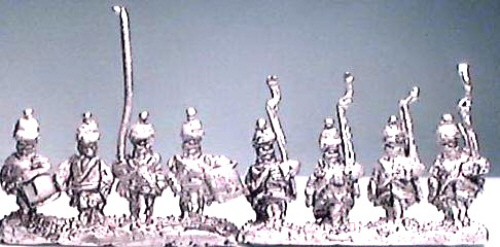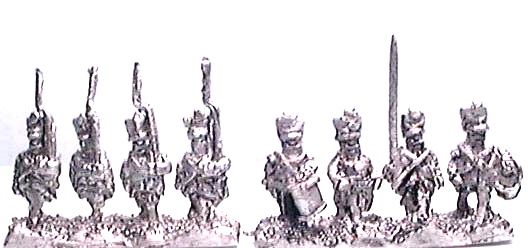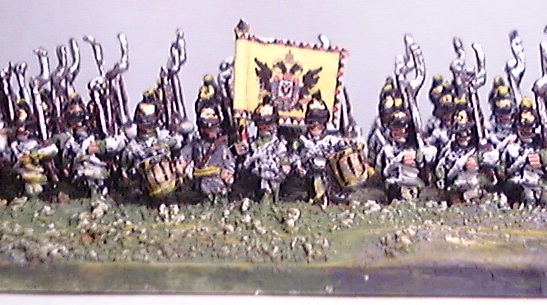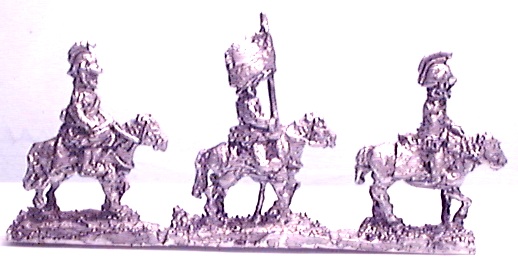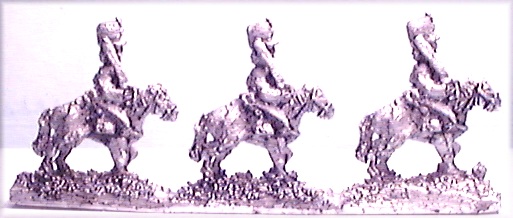|
|
|||||||||||||||||
 |
|||||||||||||||||
 |
||||||||||||
|
Originally Published on the Spanner and the Yank Web Site. Used by permission. |
||||||||||||
|
Note from the DeepFriedHappyMice editor: I have updated the Baccus web site address.] I asked Peter to review his own range for two reasons- 1. We haven't covered 6 mm yet; 2. We hadn't heard of the range. There's also '3.'- I wanted to use some graphics from his site *grin*. In case you didn't know, this is the site with the great uniform guides for the WSS (Marlborough's little spats) and can be reached by clicking on the title. The smart-alec comments in blue are all mine, don't blame Peter. Dal. 'Please give us a review of your figures,' the man says, 'and we'll vet it to make sure that you aren't giving them too much praise…'. Well, I'm damned if I do and damned if I don't it seems! (Yeah, probably. I didn't say it would be easy.) So it's up to me to give you as objective a view of some of my figures without praising them to the Heavens or sounding like a boring catalogue listing. So I thought I might liven up the process by giving you a bit of insight into the thinking that went into the range. If you are used to 15 mm or 25 mm castings, the criteria by which 6 mm figures ranges should be judged may seem unfamiliar. With the tinies the need for every last strap, button and moustache to be present is simply not there. Nor are we looking for x number of variations in pose and stance. We are looking for models that will combine together to make impressive looking large units. We are looking for figures that contain enough appropriate detail to make them easy to paint. We are looking for figures that reflect their historical counterparts and just as with the larger figures are recognizable for what they are supposed to represent before the paint is applied. With all this said, lets examine the brand new range of Baccus 6 mm Napoleonic figures; LINE INFANTRY The line infantry are supplied four to a 20 mm strip, all facing forward. This makes them easy to paint and easy to base. The command elements contain two drummers, an officer and an ensign. They are sold in packs of 20 containing four command and sixteen regular strips, although these ratios can be varied on request.
Austrian line- front and back views at about 350% magnification (remember, these are shots of 6 mm figures. All the figure shots here have been enlarged and contrast turned up for your viewing ease and because I like meddling). The cost is £2.80 per pack. That works out to £0.14 per strip, or £0.035 per figure! NAU1 Line Infantry in Shako All of these three codes share the same basic pose. They are advancing with left leg leading, facing forward, musket cradled in the crook of the left arm and with the right arm by the side of the body. I will admit, not the most imaginative pose, but ask any Napoleonic reenactor which is the best drill position for advancing in combat and you will soon have this one shown to you.
Hungarian line- front and back views. The Line officers are wearing the practical uberrock. There are no separate codes for German or Hungarian regiments. Given the minute apparent differences that modeling in this scale would produce, I opted to let the buyer use his paint palette to distinguish between the light blue pantaloons of the Hungarians and the white of the Germans. The great thing about this scale is that there is NO imperative to ruin your eyesight by painting large amounts of black and yellow speckled lace… That's the physical description out of the way. But what about quality? Here you have to trust my objectivity. And if I say so myself, these are amongst some of my finest work to date. The tricky Austrian helmet is well proportioned with helmet peak and crest clearly modeled. Facial details are clear and the grenadiers have moustaches, straps can be clearly seen on the knapsacks and the greatcoat bundles. The drummers have the distinctive 'over the shoulder' version of the backpack and the Grenadiers' bonnets are both furry and fearsome.
A battalion with the odd touch of paint applied. They are also a doddle to paint. A quick white drybrush over a black undercoat and you have done over half the work. JAGERS All Baccus light infantry are supplied four to a strip. The figures are placed one behind the other single file. This format enables me to model figures with leveled muskets. They are sold in packs of 10 at £1.40 per pack. NAU4 Jaegers in Helmet
Skirmishers in corsehut. The Austrians didn't go a bundle for light infantry, but everyone likes Jaegers it seems. Both codes have two main poses, one firing and one loading. I chose these poses as military doctrine at the time dictated that skirmishers operate in pairs, one covering the other while he loaded. Once again, the headgear is clearly and distinctly modeled and even the long sword bayonet scabbard is in evidence. CAVALRY All Baccus cavalry come in the same pose with the sabre drawn, hilt resting on the right knee, on a walking horse. Now to many this may seem a boring pose, but it is carefully chosen. For a start it means the horse is anchored to the base by all four feet, making a nice strong figure. Secondly it is easy to paint and show off regimental uniform differences. Thirdly is a true wargames pose. These are not diorama figures, nor am I trying to win a modeling competition. Personally I dislike units that always seem to be engaged in mortal combat even when they are supposed to be sitting at the back of the reserve line (Hear, hear!! Charging dragoons look nice the first time you do a few. But two brigades of hyperactive swordsmen frozen mid-gallop and sitting behind your front line looks bloody silly after about 3.7 seconds!). Mounted figures come based in single file in threes. There are fifteen strips to a pack. Three of these are command elements consisting of an officer, a cornet and a trumpeter.
Cavalry command strip at top and the real soldiers below. The cost is £3.95 per pack. That works out to £0.26 per strip, or £0.087 per figure. NAU 7 Heavy Cavalry The first point is that there is only once code to cover all Austrian Heavy Cavalry - Cheveux Legers, Dragoons and Kurassiers. Austrian uniforms were so standardised that at this scale there is effectively no difference between the various troop types. The helmet is the early and mid war pattern, with a lower comb. NAU8 Hussars I find modeling hussars to be great fun, as the slung pelisses make great subjects for sculpting. However, in this case I decided to make the hussars look like units on campaign. As a result they are wearing their pelisses as jackets, and look very workmanlike. On the other hand, I decided that the command elements should not let the side down so they are bedecked in their parade ground best. NAU9 Uhlans I normally limit myself to one variation of a figure type within a range. The Uhlans represented a challenge as they changed their style of headgear three times within the period. I opted to go for a mid war style of czapka. The fact that at a push they will also double for polish lancers had nothing to do with this decision… ARTILLERY Baccus Artillery models generally consist of a combined carriage/barrel/base casting with two separate wheels, and a strip of four crew. The reason for keeping the base on the model is to allow for two points of contact when gluing the wheels to the model, thus making the finished model much stronger. The cost is £1.80 per pack. That works out to £0.45 per gun model and four crew. NAU10 Austrian Artillery. The crew is wearing a bicorne hat and typical Austrian short-skirted coat. There is the standard rammer, ammunition carrier, trailspike operative and obligatory man standing around, shouting orders but not doing anything. (ie an officer!) FLAGS Flags are a vital part of any wargames unit, in 6 mm especially so. I do flag sheets to support all my figures. They are generously proportioned, but still measure less than 10 mm across at the widest point. Being either a perfectionist or a man who doesn't get out enough, I have provided the 1796, 1804 and 1806 patterns. And yes, you can tell one from the other.
Said packs of flags (reproduced by me at 72 dpi, hence the grainy look. Unfortunately there's only so much space on the server...). They are sold for £1.00 per sheet of 24 flags, that is £0.024 each. Conclusion A lot of people knock 6 mm figures as being poorly designed or incapable of carrying detail. I would hope that the Baccus ranges prove them wrong. If you like to lovingly caress each carefully chosen miniature masterpiece with a paint brush, then 6 mm figures really are not for you. If you are attracted to large volume, low cost, high speed of painting and BIG units then these are well worth a try. More figures, more pictures, a quick and dirty guide to painting 6 mm figures and my full listing go to http://www.Baccus6mm.com Peter Berry
|
||||||||||||
 |
|||
|
|
|||
